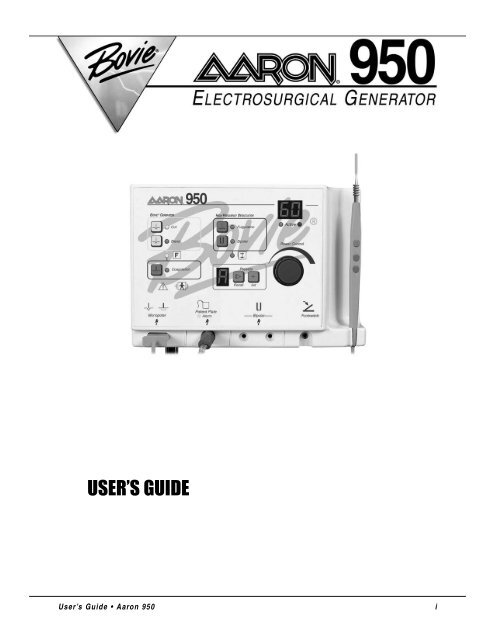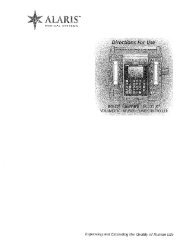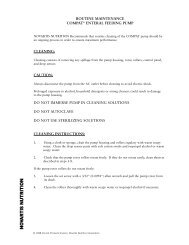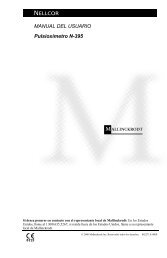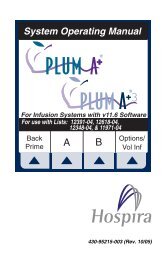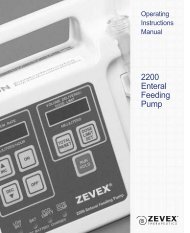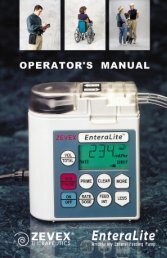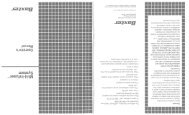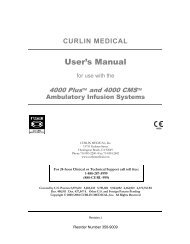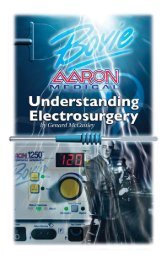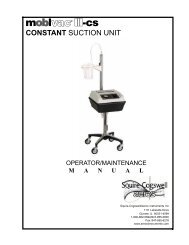Aaron Bovie 950 User Manual - Med-E-Quip Locators
Aaron Bovie 950 User Manual - Med-E-Quip Locators
Aaron Bovie 950 User Manual - Med-E-Quip Locators
- No tags were found...
You also want an ePaper? Increase the reach of your titles
YUMPU automatically turns print PDFs into web optimized ePapers that Google loves.
ii<strong>Bovie</strong> / <strong>Aaron</strong> <strong>Med</strong>ical
Technical Specifications......................................................................................................A-1Performance Characteristics...........................................................................................A-2Input Power.............................................................................................................A-2Duty Cycle...............................................................................................................A-2Dimensions and Weight ..........................................................................................A-2Operating Parameters.............................................................................................A-2Transport and Storage ............................................................................................A-2Audio Volume..........................................................................................................A-3Low Frequency (50–60 Hz) Leakage Current.........................................................A-3High Frequency (RF) Leakage Current ..................................................................A-3Standards and IEC Classifications .................................................................................A-4Class I Equipment (IEC 60601-1) ...........................................................................A-4Type BF Equipment (IEC 60601-1) / Defibrillator Proof..........................................A-4Drip Proof (IEC 60601-2-2).....................................................................................A-4Electromagnetic Interference ..................................................................................A-4Electromagnetic Compatibility (IEC 60601-1-2 and IEC 60601-2-2) ......................A-4Voltage Transients (Emergency Generator Mains Transfer)...................................A-4Output Characteristics ....................................................................................................A-5Maximum Output for Bipolar and Monopolar Modes ..............................................A-5Output Power Curves......................................................................................................A-6Monopolar Cut Curves ............................................................................................A-6Monopolar Coag Curves .........................................................................................A-8Bipolar Curves.......................................................................................................A-10Accessories...........................................................................................................................B-1Footswitches ...................................................................................................................B-2Electrosurgical Pencils....................................................................................................B-2Dispersive Electrodes .....................................................................................................B-2Disposable Active Electrodes..........................................................................................B-3Blade Electrodes.....................................................................................................B-3Needle Electrodes...................................................................................................B-3Ball Electrodes ........................................................................................................B-3LLETZ Electrodes ...........................................................................................................B-4Ball Electrodes ........................................................................................................B-4Loop Electrodes ......................................................................................................B-4Reusable Active Electrodes ............................................................................................B-5Bipolar Forceps (Reusable) ............................................................................................B-5Mounting Options............................................................................................................B-6Warranty ................................................................................................................................C-1<strong>User</strong>’s Guide • <strong>Aaron</strong> <strong>950</strong>v
LIST OF FIGURESFigure 2 – 1 Layout of controls, indicators, and receptacles on the front panel....................2-2Figure 2 – 2 Controls for the cut, blend, and coag modes ....................................................2-4Figure 2 – 3 Controls for the fulguration and bipolar modes and presets .............................2-5Figure 2 – 4 Indicators and receptacles.................................................................................2-6Figure 2 – 5 Layout of controls and indicators on the rear and side panels .........................2-7Figure 3 – 1 Mounting kit .......................................................................................................3-2Figure 4 – 1 Setup procedures ..............................................................................................4-8Figure A – 1 Output power versus impedance for cut mode.................................................A-6Figure A – 2 Peak voltage versus power setting for cut mode..............................................A-6Figure A – 3 Output power versus impedance for blend mode.............................................A-7Figure A – 4 Peak voltage versus power setting for blend mode..........................................A-7Figure A – 5 Output power versus impedance for coagulation mode ...................................A-8Figure A – 6 Peak voltage versus power setting for coagulation mode ................................A-8Figure A – 7 Output power versus impedance for fulguration mode.....................................A-9Figure A – 8 Peak voltage versus power setting for fulguration mode .................................A-9Figure A – 9 Output power versus impedance for bipolar mode.........................................A-10Figure A – 10 Peak voltage versus power setting for bipolar mode....................................A-10vi<strong>Bovie</strong> / <strong>Aaron</strong> <strong>Med</strong>ical
KEY FEATURESThe <strong>Aaron</strong> <strong>950</strong> Electrosurgical Generator includes the latest technology. This unit offers unsurpassed performance,flexibility, reliability, and convenience.It includes the following features:•Two levels of coagulation: Pinpoint Coagulation and FulgurationPinpoint Coagulation provides precise control of bleeding in localized areas.Fulguration provides greater control of bleeding in highly vascular tissue over broad surface areas.•PresetsThe unit incorporates six user-defined presets for easy recall of frequently used settings.• Isolated RF output for Cut, Blend, and Coag modesThis minimizes the potential of alternate site burns.•Ground Referenced RF output for Fulguration mode• Self diagnosticsThese diagnostics continually monitor the unit to ensure proper performance.COMPONENTS AND ACCESSORIESYou should receive the following components with your generator:•<strong>Aaron</strong> <strong>950</strong> Electrosurgical Generator• 50 sharp and 50 blunt non-sterile dermal tips•Five disposable electrodes (3 blades, 1 ball, 1 needle)• One reusable grounding cord•Five disposable grounding pads• A901 Handpiece• Ten A910 handpiece drapes• Hospital-grade power cord• Wall mount bracket• <strong>User</strong>’s GuideSAFETYThe safe and effective use of electrosurgery depends to a large degree on factors solely under the control of theoperator. There is no substitute for a properly trained and vigilant medical staff. It is important that they read,understand, and follow the operating instructions supplied with this electrosurgical equipment.Physicians have used electrosurgical equipment safely in numerous procedures. Before starting any surgical procedure,the surgeon should be familiar with the medical literature, complications, and hazards of using electrosurgery in thatprocedure.To promote the safe use of the <strong>Aaron</strong> <strong>950</strong> Electrosurgical Generator, this section presents the warnings andcautions that appear throughout this user’s guide. So that you can operate this equipment with maximum safety,it is important that you read, understand, and follow the instructions in these warnings and cautions. It is alsoimportant that you read, understand, and follow the instructions for use in this user’s guide.1-2 <strong>Bovie</strong> / <strong>Aaron</strong> <strong>Med</strong>ical
WARNINGS:Hazardous Electrical Output - This equipment is for use only by trained, licensed physicians.Danger: Fire / Explosion Hazard - Do not use the <strong>Aaron</strong> <strong>950</strong> electrosurgical generator in thepresence of flammable anesthetics.Fire / Explosion Hazard - The following substances will contribute to increased fire andexplosion hazards in the operating room:• Flammable substances (such as alcohol based skin prepping agents and tinctures)• Naturally occurring flammable gases which may accumulate in body cavities such asthe bowel• Oxygen enriched atmospheres• Oxidizing agents (such as nitrous oxide [N 2 0] atmospheres)The sparking and heating associated with electrosurgery can provide an ignition source.Observe fire precautions at all times. When using electrosurgery in the same room with anyof these substances or gases, prevent their accumulation or pooling under surgical drapes,or within the area where electrosurgery is performed.Connect the power cord to a properly polarized and grounded power source with the frequencyand voltage characteristics that match those listed on the back of the unit.Electric Shock Hazard - Connect the generator power cord to a properly grounded receptacle.Do not use power plug adapters.Electric Shock Hazard - Always turn off and unplug the generator before cleaning.Fire Hazard - Do not use extension cords.Patient Safety - Use the generator only if the self-test has been completed as described.Otherwise, inaccurate power outputs may result.Failure of the high frequency electrosurgical equipment could result in an unintended increaseof output power.The instrument receptacles on this generator are designed to accept only one instrument ata time. Do not attempt to connect more than one instrument at a time into a given receptacle.Doing so will cause simultaneous activation of the instruments.Use the lowest output setting necessary to achieve the desired surgical effect. Use the activeelectrode only for the minimum time necessary in order to lessen the possibility of unintendedburn injury. Pediatric applications and/or procedures performed on small anatomic structuresmay require reduced power settings. The higher the current flow, and the longer the current isapplied, the greater the possibility of unintended thermal damage to tissue, especially duringuse on small structures.Use electrosurgery with caution in the presence of internal or external pacemakers. Interferenceproduced by the use of electrosurgical devices can cause devices such as a pacemaker toenter an asynchronous mode or can block the pacemaker effect entirely. Consult the pacemakermanufacturer or hospital Cardiology Department for further information when use of electrosurgicalappliances is planned for patients with cardiac pacemakers.If the patient has an Implantable Cardioverter Defibrillator (ICD), contact the ICD manufacturerfor instructions before performing an electrosurgical procedure. Electrosurgery may causemultiple activation of ICDs.Do not use electrosurgical equipment unless properly trained to use it in the specific procedurebeing undertaken. Use by physicians without such training has resulted in serious, unintendedpatient injury, including bowel perforation and unintended, irreversible tissue necrosis.For surgical procedures where the high frequency current could flow through parts of the bodyhaving a relatively small cross-sectional area, the use of bipolar techniques may be desirable toavoid unwanted coagulation.In some circumstances, potential exists for alternate site burns at points of skin contact(e.g., between the arm and the side of the body). This occurs when electrosurgical currentseeks a path to the patient return electrode that includes the skin-to-skin contact point.Current passing through small skin-to-skin contact points is concentrated and may causea burn. This is true for grounded, ground referenced, and isolated output generators.<strong>User</strong>’s Guide • <strong>Aaron</strong> <strong>950</strong>1-3
WARNINGS:To reduce the potential for alternate site burns, do one or more of the following:• Avoid skin-to-skin contact points, such as fingers touching leg, when positioning the patient.• Place 5 to 8 cm (2 to 3 in.) of dry gauze between contact points to ensure that contact doesnot occur.• Position the patient return electrode to provide a direct current route between the surgicalsite and the return electrode which avoids skin-to-skin contact areas.• In addition, place patient return electrodes according to the manufacturer’s instructions.Potential for alternate site burns increases if the return electrode is compromised.Do not wrap the accessory cords or patient return electrode cords around metal objects. Thismay induce currents that could lead to shocks, fires, or injury to the patient or surgical team.CAUTIONS:At no time should you touch the active electrode or bipolar forceps. A burn could result.Do not stack equipment on top of the generator or place the generator on top of electricalequipment. These configurations are unstable and/or do not allow adequate cooling.Provide as much distance as possible between the electrosurgical generator and other electronicequipment (such as monitors). An activated electrosurgical generator may cause interferencewith them.Nonfunction of the generator may cause interruption of surgery. A backup generator should beavailable for use.Do not turn the activation tone down to an inaudible level. The activation tone alerts the surgicalteam when an accessory is active.When using a smoke evacuator in conjunction with the electrosurgical generator, place the smokeevacuator a distance from the generator and set the generator volume control at a level thatensures that the activation tones can be heard.The use of high frequency current can interfere with the function of other electromagneticequipment.When high frequency surgical equipment and physiological monitoring equipment are usedsimultaneously on the same patient, place any monitoring electrodes as far as possible fromthe surgical electrodes. Monitoring systems incorporating high frequency current limiting devicesare recommended.Do not use needles as monitoring electrodes during electrosurgical procedures. Inadvertentelectrosurgical burns may result.To avoid the possibility of an electrosurgical burn to either the patient or the physicians, donot allow the patient to come in contact with a grounded metal object during activation.When activating the unit, do not allow direct skin contact between the patient and the physician.Remove any loose fitting jewelry from the patient before activation.Examine all accessories and connections to the electrosurgical generator before use. Ensure thatthe accessories function as intended. Improper connection may result in arcs, sparks, accessorymalfunction, or unintended surgical effects.When not using active accessories, place them in a holster or in a clean, dry, nonconductive,and highly visible area not in contact with the patient. Inadvertent contact with the patient mayresult in burns.Studies have shown that smoke generated during electrosurgical procedures can be potentiallyharmful to patients and the surgical team. These studies recommend adequately ventilating thesmoke by using a surgical smoke evacuator or other means. 11. U.S. Department of Health and Human Services. National Institute for Occupational Safetyand Health (NIOSH). Control of Smoke from Laser / Electric Surgical Procedures. HAZARDCONTROLS, Publication No. 96-128, September, 1996).1-4 <strong>Bovie</strong> / <strong>Aaron</strong> <strong>Med</strong>ical
NOTICES:Do not clean the generator with abrasive cleaning or disinfectant compounds, solvents, or othermaterials that could scratch the panels or damage the generator.<strong>User</strong>’s Guide • <strong>Aaron</strong> <strong>950</strong>1-5
1-6 <strong>Bovie</strong> / <strong>Aaron</strong> <strong>Med</strong>ical
CONTROLS, INDICATORS, AND RECEPTACLESThis section describes:● The Front, Rear, and Side Panels● Controls, Indicators, and Receptacles<strong>User</strong>’s Guide • <strong>Aaron</strong> <strong>950</strong>2-1
FRONT PANELFigure 2 – 1 Layout of controls, indicators, and receptacles on the front panel2-2 <strong>Bovie</strong> / <strong>Aaron</strong> <strong>Med</strong>ical
Symbols on the Front PanelThe following table lists descriptions for symbols found on the front panel of the <strong>Aaron</strong> <strong>950</strong>.SYMBOLSGenerator ControlsDESCRIPTIONCut modeBlend modeCoagulation modeHigh Frequency Desiccator ControlsPresetsIndicatorsHandpiece ConnectorsBipolar modeFulguration modeSelect next presetSet new presetRF ground referencedDefibrillator proof type BF equipmentRF Isolated – patient connections are isolated from earth at high frequency.Read instructions before use.Caution - high voltageMonopolar handpiecePatient return electrodeFootswitchBipolar forceps<strong>User</strong>’s Guide • <strong>Aaron</strong> <strong>950</strong>2-3
CUT, BLEND, AND COAG CONTROLSFigure 2 – 2 Controls for the cut, blend, and coag modesCut ModeSelectorWhen pressed,selects the purecut mode.Cut IndicatorIndicates whenpure cut modeis selected.Cut, Blend Active IndicatorIndicates that the powerhas been activated in theselected mode.Power Display (watts)Indicates the power set forthe selected mode.Blend ModeSelectorWhen pressed,selects theblended cut mode.Blend IndicatorIndicates whenblended cutmode is selected.Coag, Fulguration, BipolarActive IndicatorIndicates that the powerhas been activated in theselected mode.RF Isolated IndicatorIndicates when theRF output is isolatedfrom the ground.Coag Mode SelectorWhen pressed, selectsthe coagulation mode.Coag IndicatorIndicates whencoagulation modeis selected.Power OutputControl KnobTurn clockwise toincrease power output,counterclockwise todecrease power output.2-4 <strong>Bovie</strong> / <strong>Aaron</strong> <strong>Med</strong>ical
FULGURATION, BIPOLAR, AND PRESET CONTROLSFigure 2 – 3 Controls for the fulguration and bipolar modes and presetsFulgurationMode SelectorWhen pressed,selects thefulguration mode.Fulguration IndicatorIndicates whenfulguration modeis selected.Cut, Blend Active IndicatorIndicates that the powerhas been activated in theselected mode.Power Display (watts)Indicates the power set forthe selected mode.Bipolar ModeSelectorWhen pressed,selects thebipolar mode.Bipolar IndicatorIndicates whenbipolar mode isselected.Coag, Fulguration BipolarActive IndicatorIndicates that the powerhas been activated in theselected mode.RF GroundReferenced IndicatorIndicates when the RFoutput is ground referenced.Only applies tothe fulguration mode.Presets DisplayIndicates which preset isselected (A-F). “b” and “d” aredisplayed in lowercase letters.Presets RecallSelectorWhen pressed,selects the nextpreset setting.No Presets IndicatorDot blinks to indicatewhen no user definedpreset is being used.Presets Set ButtonWhen depressed for2 seconds, makesthe current settingsthe preset lettershown in the indicatorwindow.Power OutputControl KnobTurn clockwise toincrease power output,counterclockwise todecrease power output.<strong>User</strong>’s Guide • <strong>Aaron</strong> <strong>950</strong>2-5
INDICATORS AND RECEPTACLESFigure 2 – 4 Indicators and receptaclesMonopolar HandpieceReceptacleAccepts the <strong>Aaron</strong> A9013-button handpiece cord.Patient PlateGrounding ReceptacleAccepts the <strong>Aaron</strong>A1202C reusablegrounding cord.Bipolar Cord ReceptacleAccepts the <strong>Aaron</strong> A827EUbipolar forceps cord.Footswitch ReceptacleAccepts the <strong>Aaron</strong>A1203W footswitch cord.Patient Plate Alarm IndicatorIndicates an alarm conditionregarding the patient returncord or pad.2-6 <strong>Bovie</strong> / <strong>Aaron</strong> <strong>Med</strong>ical
REAR AND SIDE PANELSFigure 2 – 5 Layout of controls and indicators on the rear and side panelsSymbols on the Rear PanelSYMBOLSDESCRIPTIONVolume controlFuse enclosedRead Instructions Before UseSymbols on the Side PanelSYMBOLSDESCRIPTIONNon-ionizing RadiationDanger - Explosion Risk If Used With Flammable Anesthetics.<strong>User</strong>’s Guide • <strong>Aaron</strong> <strong>950</strong>2-7
2-8 <strong>Bovie</strong> / <strong>Aaron</strong> <strong>Med</strong>ical
INITIAL INSPECTIONWhen you first unpack your <strong>Aaron</strong> <strong>950</strong> Electrosurgical Generator, inspect it visually:• Look for any signs of damage.• Verify that the shipping package contains all items listed on the packing list.If the unit or any accessories are damaged, notify <strong>Aaron</strong> <strong>Med</strong>ical’s Customer Service immediately. Do not use anydamaged equipment.INSTALLING THE UNIT1. Mount the <strong>Aaron</strong> <strong>950</strong> Electrosurgical Generator on the wall or optional stand using the mounting kit.(See Figure 3 - 1)CAUTION:The unit is not to be utilized in the horizontal position, as liquids may easily spill into the unit.If mounting on a wall surface, a qualified individual should be consulted to avoid damage to thewall surface.Figure 3 – 1 Mounting kit2. Plug the female end of the supplied power cord into the base of the unit and the male end into a groundedwall receptacle.WARNING:Connect the power cord to a properly polarized and grounded power source with the frequencyand voltage characteristics that match those listed on the back of the unit.3-2 <strong>Bovie</strong> / <strong>Aaron</strong> <strong>Med</strong>ical
USING THE AARON <strong>950</strong>This section contains the following procedures:● Inspecting the Generator and Accessories● Setup Safety● Setting Up● Preparing for Monopolar Surgery● Preparing for Bipolar Surgery● Activation Safety● Activating the UnitCAUTIONSRead all warnings, cautions, and instructions provided with this generator before use.Read the instructions, warnings, and cautions provided with electrosurgical accessories beforeuse. Specific instructions are not included in this manual.<strong>User</strong>’s Guide • <strong>Aaron</strong> <strong>950</strong>4-1
INSPECTING THE GENERATOR AND ACCESSORIESBefore each use of the <strong>Aaron</strong> <strong>950</strong> Electrosurgical Generator, verify that the unit and all accessories are in goodworking order:•Inspect for damage to the Electrosurgical Generator and all its connections.•Verify that the appropriate accessories and adapters are present.•Inspect all cords and connectors for signs of wear, damage, and abrasion.•Verify that no errors occur when you turn on the unit.SETUP SAFETYWARNINGSHazardous Electrical Output - This equipment is for use only by trained, licensed physicians.Electric Shock Hazard - Connect the generator power cord to a properly grounded receptacle.Do not use power plug adapters.Connect the power cord to a properly polarized and grounded power source with the frequencyand voltage characteristics that match those listed on the back of the unit.Fire Hazard - Do not use extension cords.Patient Safety - Use the generator only if the self-test has been completed as described.Otherwise, inaccurate power outputs may result.The instrument receptacles on this generator are designed to accept only one instrument at atime. Do not attempt to connect more than one instrument at a time into a given receptacle.Doing so will cause simultaneous activation of the instruments.Failure of the high frequency electrosurgical equipment could result in an unintended increase ofoutput power.Do not use electrosurgical equipment unless properly trained to use it in the specific procedurebeing undertaken. Use by physicians without such training has resulted in serious, unintendedpatient injury, including bowel perforation and unintended, irreversible tissue necrosis.For surgical procedures where the high frequency current could flow through parts of the bodyhaving a relatively small cross-sectional area, the use of bipolar techniques may be desirable toavoid unwanted coagulation.If the patient has an Implantable Cardioverter Defibrillator (ICD), contact the ICD manufacturer forinstructions before performing an electrosurgical procedure. Electrosurgery may cause multipleactivation of ICDs.In some circumstances, potential exists for alternate site burns at points of skin contact (e.g.,between the arm and the side of the body). This occurs when electrosurgical current seeks a pathto the patient return electrode that includes the skin-to-skin contact point. Current passing throughsmall skin-to-skin contact points is concentrated and may cause a burn. This is true for grounded,ground referenced, and isolated output generators.To reduce the potential for alternate site burns, do one or more of the following:• Avoid skin-to-skin contact points, such as fingers touching leg, when positioning the patient.• Place 5 to 8 cm (2 to 3 in.) of dry gauze between contact points to ensure that contact doesnot occur.• Position the patient return electrode to provide a direct current route between the surgicalsite and the return electrode which avoids skin-to-skin contact areas.• In addition, place patient return electrodes according to the manufacturer’s instructions.Potential for alternate site burns increases if the return electrode is compromised.4-2 <strong>Bovie</strong> / <strong>Aaron</strong> <strong>Med</strong>ical
6. Choose the Monopolar mode of operation by pressing the desired membrane switch on the front panel(see figure 4-1, letter A). Monopolar modes include Cut, Blend, Coagulation, and Fulguration.7. Set the output power either by using the dial on the front of the unit (see figure 4-1, letter J) or by the up and downbuttons on the handpiece (see figure 4-1, letter K). When power level adjustment is being made by the handpiece anaudible tone will sound to indicate that the power level has been changed. Depressing and holding the up or downbuttons will cause the power settings to change more rapidly for quick adjustment of the output power. Power outputis displayed in one watt increments for Cut, Blend, and Coagulation mode. The maximum power for each ofthese modes is 60 watts. Power is displayed in “.1” watt increments below ten watts and in whole numbers from tento 35 watts.NOTICE:The output settings cannot be adjusted when the unit is being activated.8. The unit is now ready to perform surgery. Refer to Activating the Unit later in this section.PREPARING FOR BIPOLAR SURGERY1. Insert the two connectors from the bipolar cable into the bipolar cord receptacles (see figure 4-1, letter D).2. Connect the desired forcep to the operating end of the bipolar cord.3. Plug the footswitch cable into the footswitch jack (see figure 4-1, letter E). A footswitch is required to activate theBipolar mode.NOTICE:Dispersive electrodes are not utilized during bipolar procedures.4. Select the Bipolar mode by pressing the membrane switch on the front of the unit (see figure 4-1, letter A).5. Set the output power either by using the dial on the front of the unit (see figure 4-1, letter J) or by the up and downbuttons on the handpiece (see figure 4-1, letter K). When power level adjustment is being made by the handpiece anaudible tone will sound to indicate that the power level has been changed. Depressing and holding the up or downbuttons will cause the power settings to change more rapidly for quick adjustment of the output power. Power isdisplayed in “.1” watt increments below ten watts and in whole numbers from ten to 30 watts.NOTICE:The output settings cannot be adjusted when the unit is being activated.6. The unit is now ready to perform surgery. Refer to Activating the Unit later in this section.<strong>User</strong>’s Guide • <strong>Aaron</strong> <strong>950</strong>4-5
ACTIVATION SAFETYWARNINGSDo not wrap the accessory cords or patient return electrode cords around metal objects.This may induce currents that could lead to shocks, fires, or injury to the patient or surgical team.Danger: Fire / Explosion Hazard - Do not use the <strong>Aaron</strong> <strong>950</strong> Electrosurgical Generator in thepresence of flammable anesthetics.Fire / Explosion Hazard - The following substances will contribute to increased fire and explosionhazards in the operating room:• Flammable substances (such as alcohol based skin prepping agents and tinctures)• Naturally occurring flammable gases that may accumulate in body cavities such as the bowel• Oxygen enriched atmospheres• Oxidizing agents (such as nitrous oxide [N 2 O] atmospheres)The sparking and heating associated with electrosurgery can provide an ignition source. Observefire precautions at all times. When using electrosurgery in the same room with any of thesesubstances or gases, prevent their accumulation or pooling under surgical drapes, or within thearea where electrosurgery is performed.Use the lowest output setting necessary to achieve the desired surgical effect. Use the activeelectrode only for the minimum time necessary in order to lessen the possibility of unintendedburn injury. Pediatric applications and/or procedures performed on small anatomic structures mayrequire reduced power settings. The higher the current flow, and the longer the current is applied,the greater the possibility of unintended thermal damage to tissue, especially during use on smallstructures.Use electrosurgery with caution in the presence of internal or external pacemakers. Interferenceproduced by the use of electrosurgical devices can cause devices such as a pacemaker to enteran asynchronous mode or can block the pacemaker effect entirely. Consult the pacemakermanufacturer or hospital Cardiology Department for further information when use ofelectrosurgical appliances is planned for patients with cardiac pacemakers.CAUTIONSThe use of high frequency current can interfere with the function of other electromagneticequipment.When high frequency surgical equipment and physiological monitoring equipment are usedsimultaneously on the same patient, place any monitoring electrodes as far as possible fromthe surgical electrodes. Monitoring systems incorporating high frequency current limiting devicesare recommended.Do not use needles as monitoring electrodes during electrosurgical procedures. Inadvertentelectrosurgical burns may result.To avoid the possibility of an electrosurgical burn to either the patient or the physicians, do notallow the patient to come in contact with a grounded metal object during activation. Whenactivating the unit, do not allow direct skin contact between the patient and the physician.Remove any loose fitting jewelry from the patient before activation.Examine all accessories and connections to the electrosurgical generator before use. Ensure thatthe accessories function as intended. Improper connection may result in arcs, sparks, accessorymalfunction, or unintended surgical effects.When not using active accessories, place them in a holster or in a clean, dry, nonconductive,and highly visible area not in contact with the patient. Inadvertent contact with the patientmay result in burns.Studies have shown that smoke generated during electrosurgical procedures can be potentiallyharmful to patients and the surgical team. These studies recommend adequately ventilating thesmoke by using a surgical smoke evacuator or other means. 11. U.S. Department of Health and Human Services. National Institute for Occupational Safetyand Health (NIOSH). Control of Smoke from Laser / Electric Surgical Procedures. HAZARDCONTROLS, Publication No. 96-128, September, 1996.)4-6 <strong>Bovie</strong> / <strong>Aaron</strong> <strong>Med</strong>ical
ACTIVATING THE UNITMonopolar Activation1. If the unit is not already set up, follow the set up procedure to prepare the unit for operation.2. Remove the handpiece from the holder. Place the handpiece in the desired position.3. To activate the unit, depress the activation button on the handpiece (see figure 4-1, letter L) or depress the pedal onthe footswitch. While the unit is activated, the appropriate audible tone is sounded and one of the activation LEDswill illuminate (see figure 4-1, letter N).4. When the procedure is completed, turn the unit off.5. Return the handpiece to the holder on the right side of the unit and remove the electrode. The electrode shouldbe disposed of after each procedure. If contamination has occurred to the handpiece, the handpiece should besterilized.NOTICE:When sterilizing the handpiece follow the manufacturer’s sterilization instructions that accompanythe handpiece.Bipolar Activation1. If the unit is not already set up, follow the set up procedure to prepare the unit for operation.2. Place the forceps in the desired position.3. To activate the unit depress the footswitch pedal. While the unit is activated, an audible tone is sounded and theblue activation LED will illuminate (see figure 4-1, letter N).4. When the procedure is completed, turn the unit off.5. Remove the forceps from the bipolar cord and sterilize.NOTICE:When sterilizing the forceps follow the manufactures sterilization instructions that accompany theforceps.<strong>User</strong>’s Guide • <strong>Aaron</strong> <strong>950</strong>4-7
<strong>950</strong>BOVIE ® GENERATOR HIGH FREQUENCY DESICCATORFigure 4 – 1 Setup procedures4-8 <strong>Bovie</strong> / <strong>Aaron</strong> <strong>Med</strong>ical
MAINTAINING THE AARON <strong>950</strong>This section covers the following topics:● Cleaning● Periodic Inspection<strong>User</strong>’s Guide • <strong>Aaron</strong> <strong>950</strong>5-1
<strong>Aaron</strong> <strong>Med</strong>ical recommends that you complete periodic inspection and performance testing. Perform inspections andperformance testing every six months. A qualified biomedical technician should conduct this testing to ensure thatthe unit is operating effectively and safely.CLEANINGAfter each use, clean the unit.WARNING:Electric Shock Hazard - Always turn off and unplug the generator before cleaning.NOTICE:Do not clean the generator with abrasive cleaning or disinfectant compounds, solvents, or othermaterials that could scratch the panels or damage the generator.1. Turn off the generator, and unplug the power cord from the wall outlet.2. Thoroughly wipe all surfaces of the generator and power cord with a mild cleaning solution or disinfectant anda damp cloth. Follow the procedures approved by your institution or use a validated infection control procedure.Do not allow fluids to enter the chassis. Do not sterilize the generator.PERIODIC INSPECTIONEvery six months, visually inspect the <strong>Aaron</strong> <strong>950</strong> Electrosurgical Generator for signs of wear or damage.In particular, look for any of the following problems:• Damage to the power cord• Damage to the power cable receptacle•Obvious damage to the unit• Damage to any receptacle•Accumulation of lint or debris in or around the unit5-2 <strong>Bovie</strong> / <strong>Aaron</strong> <strong>Med</strong>ical
TROUBLESHOOTINGThis section includes error code descriptions and actions to take to resolve them.<strong>User</strong>’s Guide • <strong>Aaron</strong> <strong>950</strong>6-1
The <strong>Aaron</strong> <strong>950</strong> Electrosurgical Generator includes automatic self-diagnostics. If the diagnostics detect an error, thesystem displays an error code, sounds an audible tone, and deactivates the unit output power.Most error codes result from faults in accessories attached to the unit. The following table lists the error codes,describes the error, and recommends actions to take to resolve the error.Error Code Description Recommended ActionF1Handswitch or monopolarfootswitch pedal may be stuck1. Turn off, then turn on the generator. Do not press buttons or activateaccessory devices during the self-test.2. If the error code reappears, disconnect all accessories.Turn off, then turn on the generator again.3. If the problem persists, replace the handpiece or footswitchand repeat the restart.4. If the error code reappears, record the number and call<strong>Aaron</strong> customer service.E2Line voltage error(Line voltage is too high)1. Turn the unit off.2. Verify that the unit is connected to the correct line voltage3. If the error code reappears, record the number and contact<strong>Aaron</strong> customer service.E5Internal temperature of the unitexceeded limit1. Turn the unit off.2. Allow the unit to cool for 20 minutes.3. Turn the unit on.4. If the error code reappears, record the number and contact<strong>Aaron</strong> customer service.If the unit displays any other error code, it requires service.6-2 <strong>Bovie</strong> / <strong>Aaron</strong> <strong>Med</strong>ical
REPAIR POLICY AND PROCEDURESRefer to this section for information on:● The Manufacturer’s Responsibility● Returning the Generator for Service<strong>User</strong>’s Guide • <strong>Aaron</strong> <strong>950</strong>7-1
RESPONSIBILITY OF THE MANUFACTURER<strong>Aaron</strong> <strong>Med</strong>ical is responsible for the safety, reliability, and performance of the generator only under the followingcircumstances:• The user has followed the installation and setup procedures in this user’s guide.•Persons authorized by <strong>Aaron</strong> <strong>Med</strong>ical performed assembly operation, readjustments, modifications, or repairs.• The electrical installation of the relevant room complies with local codes and regulatory requirements, such asIEC and BSI.•Equipment use is in accordance with the <strong>Aaron</strong> <strong>Med</strong>ical instructions for use.For warranty information, refer to Appendix C – Warranty.RETURNING THE GENERATOR FOR SERVICEBefore you return the generator, call your <strong>Aaron</strong> <strong>Med</strong>ical representative for assistance. If instructed to send thegenerator to <strong>Aaron</strong> <strong>Med</strong>ical, first obtain a Returned Goods Authorization Number. Then clean the Generatorand ship it to <strong>Aaron</strong> <strong>Med</strong>ical for service.Step 1 – Obtain a Returned Goods Authorization NumberCall the <strong>Aaron</strong> <strong>Med</strong>ical Customer Service Center to obtain a Returned Goods Authorization Number.Have the following information ready when you call:• Hospital / clinic name / customer number•Telephone number• Department / address, city, state, and zip code•Model number• Serial number• Description of the problem•Type of repair to be doneStep 2 – Clean the GeneratorWARNING:Electric Shock Hazard - Always turn off and unplug the generator before cleaning.NOTICE:Do not clean the generator with abrasive cleaning or disinfectant compounds, solvents, or othermaterials that could scratch the panels or damage the generator.A. Turn off the generator, and unplug the power cord from the wall outlet.B. Thoroughly wipe all surfaces of the generator and power cord with a mild cleaning solution or disinfectant anda damp cloth. Follow the procedures approved by your institution or use a validated infection control procedure.Do not allow fluids to enter the chassis. You cannot sterilize the generator.7-2 <strong>Bovie</strong> / <strong>Aaron</strong> <strong>Med</strong>ical
Step 3 – Ship the GeneratorA. Attach a tag to the generator that includes the Returned Goods Authorization Number and the information(hospital, phone number, etc.) listed in Step 1 – Obtain a Returned Goods Authorization Number.B. Be sure the generator is completely dry before you pack it for shipment. Package it in its original shippingcontainer, if available.C. Ship the generator, prepaid, to the address given to you by the <strong>Aaron</strong> <strong>Med</strong>ical Service Center.<strong>User</strong>’s Guide • <strong>Aaron</strong> <strong>950</strong>7-3
7-4 <strong>Bovie</strong> / <strong>Aaron</strong> <strong>Med</strong>ical
TECHNICAL SPECIFICATIONSAll specifications are nominal and subject to change without notice. A specification referred to as “typical”is within ± 20% of a stated value at room temperature (25° C / 77° F) and a nominal input power voltage.<strong>User</strong>’s Guide • <strong>Aaron</strong> <strong>950</strong>A-1
PERFORMANCE CHARACTERISTICSInput Power120 VAC ± 10% 220 VAC ± 10%Mains line frequency: 50 – 60 HzPower consumption: 240 VAFuses (two): 2.0 A (Slow Blow)Duty CycleUnder maximum power settings and rated load conditions (Pure Cut, 60 watt @ 500 Ω load), the generator issuitable for activation times of 10 seconds on, 30 seconds off for one hour.Dimensions and WeightMains line frequency: 50 – 60 HzPower consumption: 240 VAFuses (two): 1.0 A (Slow Blow)Width 26 cm (10.25 in.) Depth 11.4 cm (4.5 in.)Height 17.8 cm (7.0 in.) Weight < 15.4 kg (< 7 lbs)Operating ParametersAmbient temperature range 10° to 40° C (50° to 104° F)Relative humidityAtmospheric pressureWarm-up time30% to 75%, non-condensing700 hPa to 1060 hPaIf transported or stored at temperatures outside the operating temperature range,allow one hour for the generator to reach room temperature before use.Transport and StorageAmbient temperature range -34˚ to 65˚ C (-29˚ to 149˚ F)Relative humidity0% to 75%, non-condensingAtmospheric pressure500 hPa to 1060 hPaA-2 <strong>Bovie</strong> / <strong>Aaron</strong> <strong>Med</strong>ical
Audio VolumeThe audio levels stated below are for activation tones (bipolar, cut, and coag) and alarm tones (return electrode andsystem alarms) at a distance of one meter. Alarm tones meet the requirements for IEC 60601-2-2.Activation ToneVolume (adjustable)FrequencyDuration45 to 65 dBCut: 1 kHzBlend: 1 kHzCoagulation: 2 kHzFulguration: 2 kHzBipolar: 2 kHzContinuous while the generator is activatedAlarm ToneVolume (not adjustable)FrequencyDuration70 dB ± 5 dB2 kHz 1 ⁄2 seconds / 1 kHz 1 ⁄2 seconds2 sLow Frequency (50–60 Hz) Leakage CurrentEnclosure source current, ground open < 500 µASource current, patient leads, all outputsSink current at high line, all inputs < 50 µANormal polarity, intact ground: < 50 µANormal polarity, ground open: < 50 µAReverse polarity, ground open: < 50 µAHigh Frequency (RF) Leakage CurrentBipolar RF leakage currentMonopolar RF leakage current (additional tolerance)< 39 mA rms< 150 mA rms<strong>User</strong>’s Guide • <strong>Aaron</strong> <strong>950</strong>A-3
STANDARDS AND IEC CLASSIFICATIONSClass I Equipment (IEC 60601-1)Accessible conductive parts cannot become live in the event of a basic insulation failure because of the way in whichthey are connected to the protective earth conductor.Type BF Equipment (IEC 60601-1) / Defibrillator ProofThe <strong>Aaron</strong> <strong>950</strong> Electrosurgical Generator provides a high degree of protection against electric shock,particularly regarding allowable leakage currents. It is type BF equipment. Patient connections are isolatedfrom earth and resist the effects of defibrillator discharge.Drip Proof (IEC 60601-2-2)The generator enclosure is constructed so that liquid spillage in normal use does not wet electrical insulation or othercomponents which, when wet, are likely to affect adversely the safety of the generator.Electromagnetic InterferenceWhen other equipment is placed on or beneath an activated <strong>Aaron</strong> <strong>Med</strong>ical electrosurgical generator, the <strong>Aaron</strong> <strong>950</strong>Electrosurgical Generator operates without interference. The generator minimizes electromagnetic interference tovideo equipment used in the operating room.Electromagnetic Compatibility (IEC 60601-1-2 and IEC 60601-2-2)The <strong>Aaron</strong> <strong>950</strong> Electrosurgical Generator complies with the appropriate IEC 60601-1-2 and IEC 60601-2-2specifications regarding electromagnetic compatibility.Voltage Transients (Emergency Generator Mains Transfer)The <strong>Aaron</strong> <strong>950</strong> Electrosurgical Generator operates in a safe manner when the transfer is made between line AC andan emergency generator voltage source.A-4 <strong>Bovie</strong> / <strong>Aaron</strong> <strong>Med</strong>ical
OUTPUT CHARACTERISTICSMaximum Output for Bipolar and Monopolar ModesPower readouts agree with actual power into rated load to within 20% or 5 watts, whichever is greater.Mode Output Power Output Frequency Repetition Rate Vp-p maxCut 60 W @ 500 Ω 357 kHz ± 50 kHz N / A 1.5 KVBlend 60 W @ 800 Ω 357 kHz ± 50 kHz 30 kHz ± 5 kHz 2.0 KVCoagulation 60 W @ 1000 Ω 375 kHz ± 50 kHz 60 kHz ± 5 kHz 3.8 KVFulguration 35 W @ 1000 Ω 575 kHz ± 50 kHz 30 kHz ± 5 kHz 6.5 KVBipolar 30 W @ 200 Ω 520 kHz ± 50 kHz 19 kHz ± 5 kHz 2.0 KV<strong>User</strong>’s Guide • <strong>Aaron</strong> <strong>950</strong>A-5
OUTPUT POWER CURVESThe curves that follow depict the changes for each mode at specific power settings.Monopolar Cut CurvesThese measurements were taken using short (< 0.5 meter) leads. For each output power vs. impedance curve, theupper curve represents readings taken at full power; the lower curve, readings taken at half power.Figure A – 1 Output power versus impedance for cut modeFigure A – 2 Peak voltage versus power setting for cut modeA-6 <strong>Bovie</strong> / <strong>Aaron</strong> <strong>Med</strong>ical
Figure A – 3 Output power versus impedance for blend modeFigure A – 4 Peak voltage versus power setting for blend mode<strong>User</strong>’s Guide • <strong>Aaron</strong> <strong>950</strong>A-7
Monopolar Coag CurvesThese measurements were taken using short (< 0.5 meter) leads.Figure A – 5 Output power versus impedance for coagulation modeFigure A – 6 Peak voltage versus power setting for coagulation modeA-8 <strong>Bovie</strong> / <strong>Aaron</strong> <strong>Med</strong>ical
Figure A – 7 Output power versus impedance for fulguration modeFigure A – 8 Peak voltage versus power setting for fulguration mode<strong>User</strong>’s Guide • <strong>Aaron</strong> <strong>950</strong>A-9
Bipolar CurvesFigure A – 9 Output power versus impedance for bipolar modeFigure A – 10 Peak voltage versus power setting for bipolar modeA-10 <strong>Bovie</strong> / <strong>Aaron</strong> <strong>Med</strong>ical
ACCESSORIESThe accessories listed in this section are recommended for use with the <strong>Aaron</strong> <strong>950</strong> Electrosurgical Generator. Ensureall accessories are rated for at least the maximum peak output voltage of the generator.<strong>User</strong>’s Guide • <strong>Aaron</strong> <strong>950</strong>B-1
FOOTSWITCHESA1203W <strong>Aaron</strong> <strong>950</strong> Footswitch, EachA1203WELECTROSURGICAL PENCILSThe Standard <strong>Aaron</strong> 3-button pencil features up down controlsand activation button as well as being able to be activated by thefootswitch.A901 3-button Handpiece, EachESPH Holster for ES Pencil (sterile), Box/40ESPHA901A910 Disposable Handpiece Sheath, Box/100A910ESSP Scratch Pads (sterile), Box/40ESSPDISPERSIVE ELECTRODES<strong>Aaron</strong> disposable dispersive electrodes with super adhesive gel are designedfor single use with safety and quality built in. Where reusability is needed areusable electrode and cable are available.A1204Reusable Metal Plate and Cord, EachA1204P Reusable Replacement Plate for A1204, EachA1204C Reusable Replacement Cord for A1204, EachA1207Reusable Metal Pediatric Plate, EachA1202C Reusable Connecting Cord for A1202/ESRS, EachA1202Disposable Solid Adult Return Electrode w/o Cable, Box/5ESRS Disposable Solid Adult Return Electrode w/o Cable, Box/50A1204A1204CA1202CA1204PA1207A1202ESRSB-2 <strong>Bovie</strong> / <strong>Aaron</strong> <strong>Med</strong>ical
DISPOSABLE ACTIVE ELECTRODESAll electrodes utilize the standard 3/32" stainless steel shafts. All electrodes feature safety grip insulators combiningpatient and user safety with easy insertion into and removal from the surgical pencil. All disposable electrodes aremanufactured to the highest standards.They come individually packaged and are sterile.Blade ElectrodesES01 Standard Blade, Box/50ES37 Modified Blade, Box/25ES18 Angled Blade Electrode, Box/25ES04 Extended Blade, Box/25ES39 Ext. Modified Blade, Box/25ES55 4" Standard Blade, Box/50(not pictured)ES54 4" Modified Blade, Box/25(not pictured)ES01ES37ES04ES39ES18Needle ElectrodesES02 Standard Needle, Box/25ES38 Modified Needle, Box/25ES03 Extended Needle, Box/25ES40 Extended Modified Needle,Box/25ES02ES03ES40ES38Ball ElectrodesES20 3/16" Ball, Box/25ES21 5/32" Ball, Box/25ES20ES21<strong>User</strong>’s Guide • <strong>Aaron</strong> <strong>950</strong>B-3
LLETZ ELECTRODESAll <strong>Aaron</strong> LLETZ Loop and Square electrodes feature tungsten wire for superior shape and integrity throughout theexcision procedure. All loops are packaged with a unique protective shell to prevent damage during shipping. Ballelectrodes are available in 3mm & 5mm sizes for fulguration and desiccation while the needle electrodes are availablefor pinpoint coagulation.Ball ElectrodesES06 Extended 3mm Ball, Box/5ES07 Extended 5mm Ball, Box/5ES06ES07Loop ElectrodesES08 5mm X 5mm Loop, Box/5ES09 10mm X 10mm Loop, Box/5ES10 15mm X 8mm Loop, Box/5ES11 15mm X 10mm Loop, Box/5ES08ES46ES12 20mm X 8mm Loop, Box/5ES13 20mm X 15mm Loop, Box/5ES31 20mm X 20mm Loop, Box/5ES42 20mm X 12mm Loop, Box/5ES43 15mm x 15mm Loop, Box/5ES44 15mm x 5mm Loop, Box/5ES45 13mm x 13mm Loop, Box/5ES46 10mm x 5mm Loop, Box/5ES47 25mm x 10mm Loop, Box/5ES51 13mm X 8mm Loop, Box/5ES52 10mm X 8mm Loop, Box/5ES53 15mm X 12mm Loop, Box/5ES41 5mm X 10mm Square, Box/5ES14 5mm X 5 mm Square, Box/5ES15 10mm X 4mm Square, Box/5ES16 10mm X 8mm Square, Box/5All sizes not pictured.ES14ES41For additional products for LLETZ/LEEP procedures, contact your <strong>Aaron</strong> Distributor.B-4 <strong>Bovie</strong> / <strong>Aaron</strong> <strong>Med</strong>ical
REUSABLE ACTIVE ELECTRODESA834 Angled, Fine Needle, EachA811 Reusable Electrode, EachA830 Angled, Sharp Electrode, EachA831 Short Angled, Ball, EachA832 Short Straight, Ball, EachA834A832M Short Straight, Ball, 3/32”, EachA833 Short Straight, Needle, 3/16”, EachA835 Long, Straight Ball, EachA836 Long, Straight Needle, EachBIPOLAR FORCEPS (REUSABLE)Reusable Bipolar Forceps are available in micro,1.0 and 2.0mm tip size and in lengths rangingfrom 4.5" to 8". These forceps are guaranteedfor twenty cycles of autoclaving. Reusable Bipolarcord is also available with quality silicone construction.A827EU Forceps Cord, Each (not pictured)A826 5" Straight, Fine, Smooth, EachA825 5 1/2" Straight, <strong>Med</strong>., Smooth, EachA824 5" Curved, Fine, Smooth, EachA823 7" Curved, Fine, Smooth, EachA822 7" Straight, Fine, Smooth, EachA826A825A824A811A830A831A832A823A832MA833A836A835A822A821A820A821 7 1/2" Bayonet <strong>Med</strong>., Smooth, EachA820 7 1/2" Bayonet Fine, Smooth, EachAll sizes and styles not pictured.A840 4" Tenzel with 5mm Tip, Coated, EachA841 3 1/2" McPherson Curved with 5mm Tip, Coated, EachA842 3 1/2" McPherson Straight with 5mm Tip, Coated, EachA843 4" Tenzel with 5mm Tip, Uncoated, EachA844 3 1/2" McPherson Curved with 5mm Tip, Uncoated, EachA845 3 1/2" McPherson Straight with 5mm Tip, Uncoated, Each<strong>User</strong>’s Guide • <strong>Aaron</strong> <strong>950</strong>B-5
MOUNTING OPTIONSThe <strong>Aaron</strong> <strong>950</strong> comes with a wall mount kit. A mobile stand is available withoptional instrument tray and smoke evacuator shelf. A stainless steel table top standis also available.A812-C Mobile Stand with Bottom Tray, Top Tray, Clamp,and 12" Height Extender, EachA812 Mobile Stand, EachA812-BTOptional Bottom Tray for Smoke Evacuator, EachA808-T Optional Top Tray for Instruments, EachA812-E Optional 12" Height Extender, EachA813 Stainless Steel Table Top Stand, EachA812-EA808-TA812(Stand Only)A812-BTA812-CA837 Replacement Wall Mount Kit, EachB-6 <strong>Bovie</strong> / <strong>Aaron</strong> <strong>Med</strong>ical
WARRANTY<strong>Aaron</strong> <strong>Med</strong>ical, a <strong>Bovie</strong> Company, warrants each product manufactured by it to be free from defects in material andworkmanship under normal use and service for the period(s) set forth below.<strong>Aaron</strong> <strong>Med</strong>ical’s obligation under this warranty is limited to the repair or replacement, at its sole option, of anyproduct, or part thereof, which has been returned to it or its Distributor within the applicable time period shownbelow after delivery of the product to the original purchaser, and which examination discloses, to <strong>Aaron</strong> <strong>Med</strong>ical’ssatisfaction, that the product is indeed, defective.This warranty does not apply to any product, or part thereof, which has been repaired or altered outside <strong>Aaron</strong><strong>Med</strong>ical’s factory in a way so as, in <strong>Aaron</strong> <strong>Med</strong>ical’s judgment, to affect its stability or reliability, or which has beensubjected to misuse, neglect, or accident.The warranty periods for <strong>Aaron</strong> <strong>Med</strong>ical products are as follows:• Electrosurgical Generators: Two years from date of shipment• Mounting Fixtures (all models): Two years from date of shipment• Footswitches (all models): Ninety days from date of shipment• Patient Return Electrodes: Shelf life only as stated on packaging• Sterile Single Use Accessories: Only as stated on packaging• Handpiece: Only as stated on packaging<strong>User</strong>’s Guide • <strong>Aaron</strong> <strong>950</strong>C-1
This warranty is in lieu of all other warranties, express or implied, including without limitation, the warranties ofmerchantability and fitness for a particular purpose, and of all other obligations or liabilities on the part of <strong>Aaron</strong><strong>Med</strong>ical.<strong>Aaron</strong> <strong>Med</strong>ical neither assumes nor authorizes any other person to assume for it any other liability in connectionwith the sale or use of any of <strong>Aaron</strong> <strong>Med</strong>ical’s products.Notwithstanding any other provision herein or in any other document or communication, <strong>Aaron</strong> <strong>Med</strong>ical’s liabilitywith respect to this agreement and products sold hereunder shall be limited to the aggregate purchase price for thegoods sold by <strong>Aaron</strong> <strong>Med</strong>ical to the customer.<strong>Aaron</strong> <strong>Med</strong>ical disclaims any liability hereunder or elsewhere in connection with the sale of this product, for indirector consequential damages.This warranty and the rights and obligations hereunder shall be construed under and governed by the laws of theState of Florida, USA.The sole forum for resolving disputes arising under or relating in any way to this warranty is the District Court of theCounty of Pinellas, State of Florida, USA.<strong>Aaron</strong> <strong>Med</strong>ical, its dealers, and representatives reserve the right to make changes in equipment built and/or sold bythem at any time without incurring any obligation to make the same or similar changes on equipment previouslybuilt and/or sold by them.C-2 <strong>Bovie</strong> / <strong>Aaron</strong> <strong>Med</strong>ical


